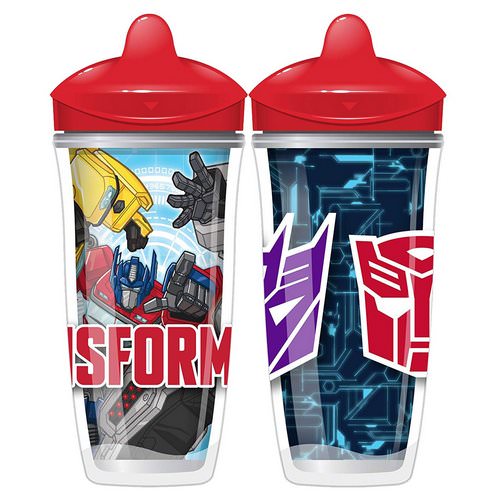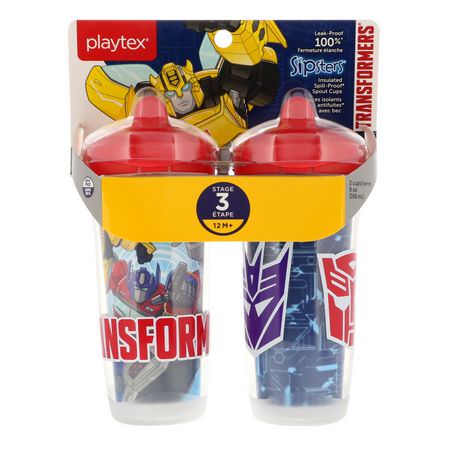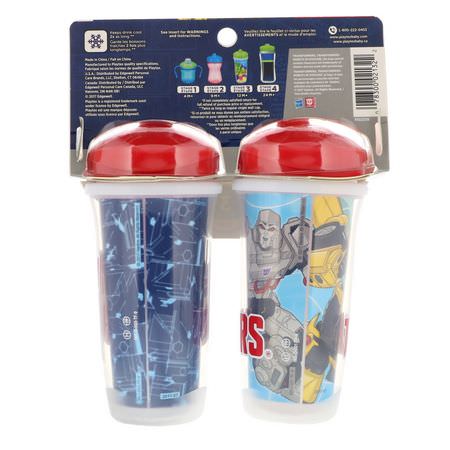Foodpharmacy Blog: Kids, Baby, Kids Feeding, Cups
Playtex Baby, Sipsters, Transformers, 12+ Months, 2 Cups, 9 oz (266 ml) Each

$7.10
Product name: Playtex Baby, Sipsters, Transformers, 12+ Months, 2 Cups, 9 oz (266 ml) Each
Quantity: 2 Count, 0.2 kg, 22.9 x 17.5 x 8.1 cm
Categories: Playtex Baby, Baby, Kids, Kids Feeding, Cups, Bpa Free
Leak-Proof 100%, Insulated Spill-Proof Spout Cups, BPA Free, Stage 3, Keeps Drink Cool 2x as Long, For over 20 years, parents have counted on Playtex for high quality, spill-proof cups that help make Toddler feeding fun and hassle-free, **Twice as long as regular single wall cup.

Although cyrus is a few months older than the recommended starting age for 360 cups, he could not figure out how to use them. Here are some tips and precautions that will ensure your baby reaps the maximum benefit from a sippy cup. The bite resistant spout keeps kids from ruining the cup, and the seal zone technology provides a 100 percent leak-proof, spill-proof, break-proof experience. Teaching your baby to use a sippy cup is challenging but is important to make him slowly discard the bottle. Recommended for babies and toddlers, the lid is carefully threaded to ensure there are no milk spills when your kid is using it. Not all children are the same, and yours may need a different sippy cup style for the transition. At this age, they would soon graduate to using cups. Learn more about how we write babylist content. After considering multiple glass sippy cups for kids, we think the green sprouts sip and straw glass cup is the best of the best when it comes to glass sippy cups. As the membrane is clear the baby can see how the liquid moves inside the cup which helps to train hand coordination. Still, now that there are many sippy cups that are completely plastic free, i am reluctant to call this one the good stuff.
Playtex Baby, Sipsters, Transformers, 12+ Months, 2 Cups, 9 oz (266 ml) Each: Cups, Kids Feeding, Kids, Baby
The silicone valve actually locks the spout closed until you start sucking on it, at which point the pressure change inside the cup opens a little plunger and your kid can drink freely. These rimless cups make it easy for babies to drink from a cup while preventing spills. It has been a great cup and my toddler seems to like it too because he seems to drink a lot more with this than the other cups we have had. Do not let your baby or toddler roam around with the sippy cup. Designed for kids 12 months and older, the tommee tippee tumbler helps toddlers learn to drink out of grownup glasses. If you are a mom who forgets cups in restaurants, or lose sippy cups on the regular, this may just be the solution. Sippy cups are great for babies or toddlers especially if they have just gotten out of their breastfeeding or bottle phase. Some pediatric experts recommend phasing out of sippy cups by 12 months. Do it gradually, as your baby gets used to the cups. I had my baby yesterday, and i just wanted to give you a shout and say thanks so much for your awesome weekly emails. If branding is going to be the deal-breaker for your kid, munchkin has versions of their cup with paw patrol and hello kitty, while nuk has pj masks and tmnt. As is the case with many products designed for children, the sippy cup was brought into existence by a frustrated parent looking to solve a problem.

With straw cups, your baby is more likely to learn the new skill of pulling her tongue to the back of her mouth when she drinks. Which sippy cup is best for a breastfed baby? Then gradually introduce the cup to your baby, stick with it, and give your baby plenty of time to get used to their new way of drinking water or milk. For kids less than 12 months old, soft spouts are recommended. Based on that, we created tools with shapes that help babies learn more quickly and make feeding easier and less messy. If your baby constantly rejects drinking from the sippy cup, then you could dip the spout in milk before putting it in his mouth. The elk and friends kids cups are beautifully simple and can double as food storage. Like anything else that is going to go into your baby’s mouth, it is imperative to make sure that sippy cups are kept as clean as possible. When he was a baby, we used the avent sippy when we were out because i liked the soft spout, but i never used the valve. As the age of the child progresses, then it is time to switch to the hard spouts.
Since then, more research has emerged, and it has become clear that pretty much all plastic food and drink containers should be avoided whenever possible. Most drinking cups are priced reasonably, which means you can experiment with them. In addition, all the first years sippy cups have interchangeable lids, so if you purchase any other of their sippy cups, you can easily switch out the lids and cups. Another downside to this design is that the vent to replace what your kid is drinking with air is basically just the seal at the base of the silicone spout. If their materials are not up to standard, it can affect the dental health of the child. Finding a cup that is rugged enough to take a toddlers abuse, easy to get the drink out when the child is intentionally drinking, and not drip as the cup is being dragged around can be a challenge. With valve and lid a child can decide how much water he needs at one sip. These gerber fun grips trainer cups are not only easy for children to hold and drink from, but they also have a number of other features which make them some pretty good sippy cups. The recommended period of time wherein a parent should introduce this type of cup to the child is when he/she is about 6 months old, because this is usually the time when they start to venture out of their mainly milk diets. A weighted straw follows the flow of milk or other liquids, making it easy for your baby to drink the entire cup. While looking for sippy cups and doing my research i found a lot of options out there.
Your pediatrician is a wonderful resource for any other questions you may have regarding weaning your child to a cup. Another key feature that can be found on this cup is it’s measurement markings which allows the parent to see just how much the child is drinking. I would give a child a sippy cup at 5-6 months, just for practice, and get serious about teaching them how to suck and drink from it between 10-12 months. It is a lot of work to help your child to grow and to become more independent. But continue with the demonstration about drinking milk from an open cup and your baby will soon learn to drink on his own. This sippy cup is ideal for young children coming off the bottle at a younger age that will be using their sippy cup for longer. But for their specific purpose as take and toss cups, they work well.
Playtex Baby Cups
Have a kiddo just learning to drink from a sippy cup? Even with this minor flaw, however, this cup should still be looked at closely by parents looking for a cup for their 12-month or older child. Sippy cups are as unique as the children who use them. Ask your pediatrician for their advice on what the right timing is for your baby. The main advantage with this cup is that it helps teach the youngest children to drink from a rim, not a spout. Also note that all the cups mentioned below are bpa-free plastic. Many other sippy cups share this feature, but some parents complain their children do not get the biting idea. Take and toss cups are great to keep at your house for visitors and for travel. This is one of many samples of sippy cups available on the market. Once you start weaning and you get into a routine of feeding, you can introduce a drink of cooled boiled water at mealtimes. The munchkin miracle 360 is a favorite for both parents and kids alike, with a spoutless design that allows for drinking from anywhere along the outer edge.
Therefore, there are a few features that parents should consider when buying a baby cup. There are two other type of baby transitional cups; those with a 360 degree drinking rim and an insulated cup. Continue to supervise your baby using a cup until they are at least 1 year old. If your baby is above 12 months, it is recommended you get sippy cups with hard spouts. Though some parents may still keep a sippy cup handy for traveling and other occasions as their child is still developing their muscle control. The sippy cups reviewed will allow your child the ability to learn to drink from a cup while preventing the child from making a mess. Soft spouts are also called stage one sippy cups. This sippy cup is designed to grow with your child.
The philips website writes that dentists recommend the short straw for exercising mouth muscles, so it might be better for an older baby who has had more practice. It was designed this way to help your child transition easier over to the sippy cup. Having one or two handles out the side of a cup definitely makes it easier for a child to hold their cup and feed themselves. Regardless, babies can be picky about cup preferences so be flexible and help your baby be flexible. That said, we think these cups are pretty awesome, and know most kids will be happy with the colors. Your child should not use a sippy cup beyond 24 months and by this age should have transitioned completely to drinking from an open cup. However, mason bottle does sell silicone bottle nipples, if you want to make a mason jar baby bottle. Around this time, a child can start transitioning from a sippy cup to a regular cup. This oxo tot transitions cup is designed to make it easier for children to hold and to drink from as they transition from a bottle.
Encourage your baby to start using their new cup, and be patient as they get used to drinking milk or water from an entirely new cup.